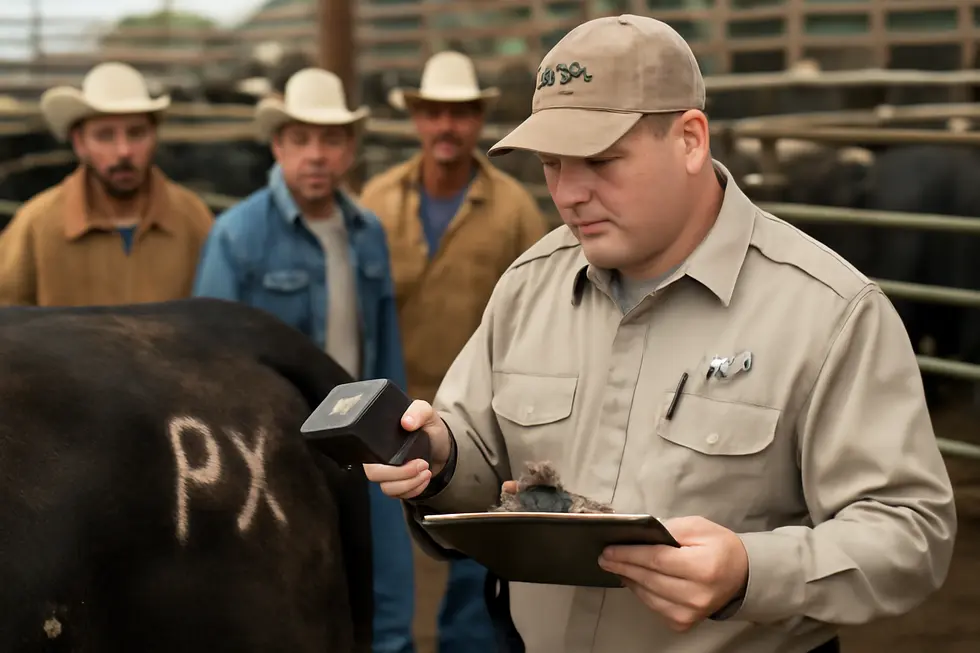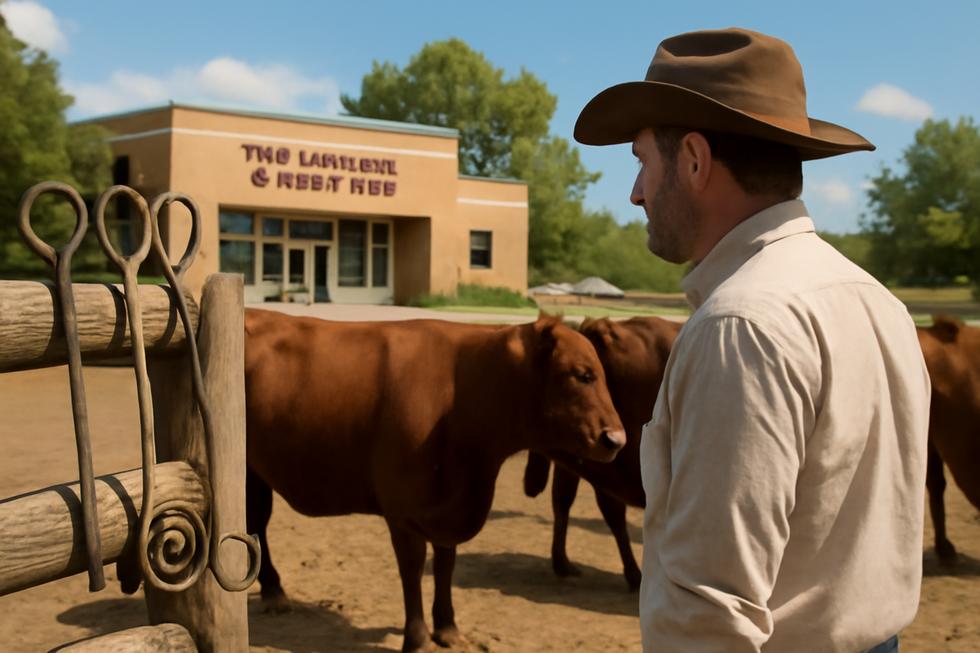Introduction
Livestock brand registration is a critical legal process that business owners must understand to protect ownership rights over their animals. Whether managing cattle, horses, or other livestock, properly registering a brand ensures unique identification and legal protection against theft or misappropriation. This process encompasses multiple facets: from submitting a unique and clear design for approval, understanding varying fee structures and legal implications, to compliance with enforcement programs and regulatory requirements. Additionally, historical brand records serve as valuable repositories for ownership verification and heritage. Each chapter in this guide addresses these key components, empowering business owners to navigate the registration system confidently and safeguard their livestock assets effectively.
Tables of Contents
Chapter 1: Design Submission and Approval Process in Livestock Brand Registration
- Crafting Unique Livestock Brands: From Design Creation to Official Approval
- Ensuring Brand Integrity through Public Notification and Objection Procedures
- Formal Registration, Documentation, and Fee Structures Ensuring Legal Brand Ownership
- Legal Protections and Ownership Transfers: Securing Your Livestock Brand Rights
Chapter 2: Fee Structures and Legal Protections in Livestock Brand Registration
- The Role of Emerging Technologies in Shaping Fees and Legal Safeguards in Livestock Branding
- Balancing Economic Realities and Regulatory Fees in Livestock Brand Ownership
- How Geopolitical Dynamics Shape Costs and Legal Safeguards in Livestock Branding
- Balancing Economic Access and Cultural Legacy Through Livestock Brand Fees and Legal Rights
Chapter 3: Inspection Programs and Enforcement in Livestock Brand Registration
- Ensuring Livestock Ownership Integrity: The Role of Inspection and Enforcement Systems
- Legal Enforcement and Vigilance Strategies Safeguarding Livestock Brand Integrity
- Streamlining Brand Registration, Renewal, and Enforcement Through Modern Inspection Technologies
- Balancing Legal Security and Economic Vitality through Livestock Brand Inspection and Enforcement
Chapter 4: Historical Records and Regulatory Compliance in Livestock Brand Registration
- Digital Innovation Transforming Historical Records and Compliance in Livestock Branding
- Economic Benefits of Leveraging Historical Brand Records and Regulatory Compliance
- Navigating Geopolitical Complexities: How Global Dynamics Shape Livestock Brand Records and Compliance
- Cultural Heritage and Legal Foundations in Livestock Brand Registration
Chapter 1: Design Submission and Approval Process in Livestock Brand Registration

1. Crafting Unique Livestock Brands: From Design Creation to Official Approval
The process of registering a livestock brand begins with careful design creation and culminates in official approval to ensure legal ownership and clear identification. Applicants must develop three simple, easily distinguishable brand designs composed of letters, numbers, or basic shapes arranged in unique combinations. These designs need to be legible when stamped onto animals, allowing for quick recognition and preventing confusion with existing brands. After selecting and ranking these designs, the applicant submits them along with a completed application and applicable fees to the relevant authority, such as a state agricultural department or livestock brand recorder.
Once submitted, a detailed review checks the proposed marks against all registered brands to confirm their uniqueness. This step guards against duplication or similarities that could lead to ownership disputes. If any design conflicts arise, applicants may be asked to revise their selections. Upon satisfying all criteria, the authority officially records the brand, issuing registration certificates and branding iron templates that precisely replicate the approved mark.
This entire approval process typically spans four to six weeks or longer, allowing for thorough examination and compliance with local laws. Only after registration is finalized may the brand be lawfully used on livestock, ensuring the owner’s exclusive rights and providing legal recourse against unauthorized branding. Through this structured approach, livestock brand registration preserves the integrity of ownership identification and supports effective management of animal resources.
For a deeper understanding of how intellectual property ties into branding and ownership protection, see trademark2go.com/trademark-protection-business-name-logo/
2. Ensuring Brand Integrity through Public Notification and Objection Procedures
The livestock brand registration process extends beyond simple design submission, involving a critical stage of public notification coupled with objection handling to safeguard ownership rights and prevent conflicts. After an applicant submits their proposed brand design—detailing the precise mark and the livestock’s branding location—the state authority undertakes a thorough review to ensure the design’s uniqueness and compliance with existing regulations. Once the initial acceptance is granted, the proposed brand enters a public notification phase. During this period, the brand is officially published in a designated state medium, such as a government bulletin or newspaper, alerting existing brand owners and the general public of the potential new entry.
This transparency allows parties who believe the new brand could cause confusion or infringement to lodge formal, written objections. Such objections serve as an essential safeguard against duplications or overly similar brands that may jeopardize legal clarity or dilute brand distinctiveness. The authority is then tasked with carefully reviewing all objections, balancing fairness between the applicant’s aspirations and the rights of existing brand holders. Depending on the outcome, the design may be modified, rejected, or cleared for final registration.
Completion of this process culminates in the issuance of a certificate of ownership, legally affirming the registrant’s exclusive right to use the approved brand on their livestock at the registered location. This framework ensures a robust system where public participation mitigates disputes and strengthens trust in brand legitimacy. Additionally, ongoing compliance obligations reinforce proper use and protect against unauthorized branding. By embedding public notification and objection protocols, livestock brand registration sustains orderly ownership recognition and enhances the overall efficacy of livestock identification systems.
For more insight into protecting marks with legal processes, consider exploring how trademark protection parallels livestock branding steps in securing exclusive rights.
3. Formal Registration, Documentation, and Fee Structures Ensuring Legal Brand Ownership
The submission of a livestock brand design initiates a formal registration process that anchors legal ownership and exclusive use rights. Applicants must carefully design a unique, simple brand that adheres to local specifications on size, complexity, and placement on animals like cattle or horses. This design must not conflict with any existing registered brands or official control marks to avoid confusion or disputes.
Once the design is finalized, a formal application is submitted to the appropriate state authority—often the Department of Agriculture or a Livestock Brand Board—with detailed owner information, a clear visual of the brand, the livestock species to be branded, and the exact location on the animal. Alongside this, a nonrefundable registration fee is required, which varies by jurisdiction and can include renewal fees to maintain current rights.
The reviewing authority rigorously examines each submission for uniqueness and compliance with standards, conducting database checks and sometimes administrative review. Designs found in conflict or failing to meet standards face rejection, with fees returned and applicants encouraged to refine and resubmit. Successful applications culminate in the issuance of a certificate of registration that legally documents brand ownership and provides an official brand facsimile for reference.
Brand owners must adhere strictly to applying the brand as approved, as unauthorized alteration or use can result in penalties. Many states also require inspections during livestock sales or transfer to verify brand authenticity and ownership integrity, thereby protecting against theft and misidentification.
Understanding and navigating this structured registration process, including the associated fees and documentation, is crucial to securing and defending legally recognized livestock brands. For detailed procedural nuances and fee schedules, consulting regional agricultural regulatory websites provides authoritative guidance. More general advice on intellectual property protection relevant to branding can be found at Trademark2Go’s comprehensive trademark protection guides.
4. Legal Protections and Ownership Transfers: Securing Your Livestock Brand Rights
The livestock brand registration process extends beyond design approval to encompass vital legal protections and clear ownership rights, ensuring secure use of registered brands. Once a brand is approved and recorded by the relevant state authority, the registrant obtains legal ownership evidenced by an official certificate. This status enables the brand to be transferred or leased, but such actions require formal documentation to protect all parties involved.
Transfers must include a bill of sale signed and notarized by both the current and prospective owners. This documentation is then recorded with the state’s livestock brand division, establishing a clear chain of title similar to real estate transactions. Leasing follows a comparable path, demanding a signed lease agreement that delineates the terms of use and is likewise filed with the registration authority. These steps safeguard the rights of both owners and users, preventing potential disputes.
State agencies enforce strict rules on brand use to maintain integrity and prevent fraud. A brand must be applied exactly as registered, both in design and on specified animals. Unauthorized branding or deviations can result in fines or misdemeanor charges, underscoring the importance of compliance. Regular inspections during sales, transports, or slaughter verify adherence to registration details and reinforce legal protections.
By mandating detailed submissions, approvals, and robust transfer protocols, the livestock brand registration system ensures brands remain unique, traceable, and legally safeguarded identifiers. For further understanding of intellectual property aspects related to brand ownership and protections, consulting resources on trademark protection for business names and logos may be helpful.
Chapter 2: Fee Structures and Legal Protections in Livestock Brand Registration

1. The Role of Emerging Technologies in Shaping Fees and Legal Safeguards in Livestock Branding
The Role of Emerging Technologies in Shaping Fees and Legal Safeguards in Livestock Branding
Livestock brand registration increasingly harnesses modern technologies, fundamentally influencing fee mechanisms and enhancing legal protections for brand owners. Central to this evolution is Electronic Identification (EID), typically utilizing RFID ear tags to provide precise and verified animal identification. This technology not only boosts traceability and disease control efforts but also solidifies legal ownership by generating tamper-resistant records of livestock movements. States like Michigan integrate EID with Premises Identification Numbers, imposing regulatory requirements that improve compliance and accountability across livestock operations.
Fee structures in brand registration reflect these technological investments. Charges cover administrative tasks, including verifying brand uniqueness and issuing legal documentation, alongside maintaining sophisticated digital databases. For instance, states with comprehensive digital systems and RFID frameworks tend to levy higher fees that correspond to the enhanced security and operational efficiency offered. Beyond RFID, emerging blockchain applications promise further advancement by creating immutable, transparent ledgers for licensing agreements and usage rights, greatly reducing disputes and fostering trust among stakeholders.
Legal protections are strengthened through this technology-driven framework. Registered brands benefit from clear presumptive ownership, supported by digital records that facilitate enforcement and deter fraudulent use. Innovative digital systems, including blockchain, improve audit trails and licensing governance, making unauthorized branding increasingly difficult to conceal. These technological strides complement traditional registration processes, ensuring livestock brands remain legally robust and economically valuable.
This modern integration of technology into fee and legal frameworks marks a pivotal shift in livestock brand registration, reflecting a move toward efficient, secure, and enforceable branding practices in today’s agricultural landscape. For deeper insights on trademark protection principles relevant to branding, see trademark protection for business names and logos.
2. Balancing Economic Realities and Regulatory Fees in Livestock Brand Ownership
Livestock brand registration frameworks serve as essential legal mechanisms that balance economic interests with regulatory needs. The associated fees are a crucial part of this balance, designed to cover administrative costs while reinforcing ownership rights, market transparency, and animal traceability. Registration fees vary widely by jurisdiction, reflecting different regional priorities and administrative budgets. For example, states like Washington charge over one hundred dollars for brand registration, whereas others such as Arizona impose considerably lower fees.
These disparities carry economic consequences for ranchers, especially small producers. Elevated fees may act as barriers to formal registration, inadvertently excluding smaller stakeholders from participating fully in regulated markets. This exclusion can affect their ability to verify ownership, access premium markets, or leverage licensing opportunities, thereby reducing overall brand equity and economic potential.
Conversely, adequate fee structures fund inspection programs and enforcement that help prevent disputes, theft, and illegal sales, which protect brand integrity and sustain market confidence. Oversight bodies must carefully calibrate fees to avoid disproportionate burdens while maintaining necessary regulatory functions. Fee increases beyond reasonable thresholds have sparked industry resistance, underscoring the delicate nature of fee policy.
Moreover, harmonized registration systems that offer clarity across state lines further enhance economic benefits by simplifying trade and reducing legal risks. Ultimately, sustainable livestock brand registration policies require a nuanced approach—ensuring fees reflect the value of ownership verification and market access, while supporting equitable participation without imposing excessive costs.
For more insight into legal protections bolstering brand security, refer to detailed information on trademark protection.
3. How Geopolitical Dynamics Shape Costs and Legal Safeguards in Livestock Branding
Livestock brand registration fees and legal protections are deeply influenced by geopolitical factors that shape agricultural policies and economic environments worldwide. Trade tensions and tariffs affect the livestock industry’s economic landscape, indirectly modifying the expenses producers face when registering their brands. For example, global beef trade restrictions can increase operational costs for ranchers, which in turn may be reflected in state or national regulatory frameworks and related fees.
Government involvement varies greatly by country, with some nations providing subsidies or insurance programs that ease financial burdens for livestock owners. This governmental support often influences both the cost and scope of legal protections attached to registered brands. Countries such as India and China have regulatory bodies and public programs that not only support producers but also define the rigor of livestock brand enforcement.
Legal protections for livestock brands also depend on national intellectual property laws and international trade agreements. Regions with strong patent systems tend to enforce brand uniqueness more strictly, bolstering legal safeguards but sometimes increasing registration complexity and fees. Additionally, political connections and corporate influence can shape regulatory leniency and fee structures through preferential access to financing and compliance flexibility.
Local livestock practices affected by environmental and market conditions further create unique regulatory demands. Breeding priorities aligned with regional climates necessitate tailored legal and branding standards. Such geopolitical and environmental nuances collectively determine how brand registration fees are set and the level of protection afforded, emphasizing how intertwined livestock branding is with broader political and economic forces.
For a deeper understanding of trademark and brand protection within business contexts, exploring resources on trademark protection business name logo is recommended.
4. Balancing Economic Access and Cultural Legacy Through Livestock Brand Fees and Legal Rights
Livestock brand registration fee structures and legal protections profoundly shape not only ownership clarity but also the broader economic and cultural landscapes of ranching communities. Higher fees, such as Washington State’s $132 initial recording or its $600 heritage brand option, can pose financial hurdles for small-scale producers. This economic barrier influences participation, often favoring larger operations that can more readily absorb these costs, potentially reducing smaller ranchers’ access to formal ownership safeguards. Yet, the legal protections conferred through registration are vital — they establish exclusive rights to a brand design, preventing unauthorized use and legal conflicts. This exclusivity underpins market transparency by reducing livestock theft and ownership disputes, thus fostering trust essential for rural economies reliant on clear identity markers.
Beyond economics, fee structures intersect with cultural preservation. Heritage brand registration programs safeguard family marks that represent generational ties and regional history, allowing brands to be preserved even without active use. This intertwines legal protections with the social fabric, reinforcing branding as a symbol of legacy. Moreover, these frameworks contribute to regulatory compliance by supporting accurate animal identification, aiding disease control and traceability initiatives crucial to public health.
In essence, the interplay of fees and legal protections within livestock brand registration not only delineates who can assert formal ownership but also helps maintain cultural heritage and ensures the livestock market’s integrity. The system’s design directly impacts economic equity, market reliability, and the preservation of ranching identities, making it a pivotal element in the stewardship of livestock ownership and community values.
For more on legal identity protections akin to brand registration in business, see information on trademark protections.
Chapter 3: Inspection Programs and Enforcement in Livestock Brand Registration

1. Ensuring Livestock Ownership Integrity: The Role of Inspection and Enforcement Systems
Inspection and enforcement programs form the backbone of livestock brand registration, ensuring legal ownership and reducing theft risks. These systems require that livestock undergo brand inspection whenever ownership is transferred, animals cross state lines, or they are sent for slaughter. The inspection itself acts as direct evidence of ownership, essential for resolving disputes and supporting legal claims.
Typically, the seller bears the responsibility and cost of obtaining a valid brand inspection certificate. Prospective buyers should insist on this documentation along with a proper bill of sale to confirm legitimacy. Laws specify strict penalties for neglecting these protocols, ranging from fines to criminal charges. States like Idaho exemplify this, treating first offenses as infractions and recurring violations as misdemeanors with financial penalties and possible jail time.
Brand registration offices maintain official records of unique brands, preventing duplication and maintaining clear ownership trails. Inspectors not only verify brands at sales, transport checkpoints, and slaughterhouses but also respond to reports of lost or stolen livestock, contributing to effective theft investigations and recovery efforts.
These programs operate within frameworks defined by state statutes, which clarify registration guidelines, inspection processes, enforcement tools, and associated penalties. Digital resources such as searchable brand registries and inspector directories enhance transparency and ease compliance.
Together, brand inspection and enforcement serve critical roles, protecting both individual livestock owners and the broader ranching economy by maintaining verifiable ownership rights and lawful livestock tracking. For more on how intellectual property parallels registration protections, see insights on trademark protection.
2. Legal Enforcement and Vigilance Strategies Safeguarding Livestock Brand Integrity
Livestock brand registration enforcement hinges on rigorous legal frameworks and proactive vigilance to protect rightful ownership and combat theft. Central to enforcement are mandatory brand inspections, which occur whenever livestock change hands. These inspections ensure that brands applied to animals are officially registered and legally transfer ownership. Failure to comply can carry serious consequences, including fines and potential jail time, reflecting the criminal nature of unauthorized branding or misrepresentation.
Law enforcement agencies play a crucial role in these programs, collaborating closely with brand inspectors to investigate reports of stolen or fraudulently sold livestock. This partnership enhances the ability to detect and prosecute offenders, reinforcing the brand’s role as a secure marker of property rights. Community participation further strengthens enforcement; ranchers and neighbors often form networks to monitor livestock movements and report suspicious activity, creating a grassroots defense against theft.
Modern technology increasingly supports these efforts. Tools like GPS trackers, drones, and surveillance cameras complement traditional inspections by enabling continuous monitoring of livestock locations and conditions. This blend of human oversight and technological aid helps maintain the integrity of brand programs.
Legal documentation—brand inspection certificates and detailed bills of sale—is mandatory for valid transactions, serving as critical evidence in any ownership dispute. Periodic audits and digital brand registries also assist regulatory bodies in tracking compliance and swiftly addressing violations.
Together, these enforcement mechanisms and legal requirements form a robust system that upholds the legitimacy of livestock brands, deters unlawful activity, and ensures owners’ rights remain protected. Such measures are vital to sustaining trust and order within the livestock industry.
For additional insights on legal protections related to business marks, see trademark protection business name and logo.
3. Streamlining Brand Registration, Renewal, and Enforcement Through Modern Inspection Technologies
Livestock brand registration forms the foundational step in securing legal ownership of animals through a unique mark recognized by state authorities. This process requires owners to submit distinctive brand designs along with a stipulated registration fee, ensuring each mark’s exclusivity and clarity to prevent overlaps. For instance, states like Washington mandate a $132 fee and scrutinize submitted designs to maintain unmistakable brand records. Beyond initial registration, maintaining the brand’s validity depends on timely renewals, typically required every four years. Renewal fees, such as a $120 charge in Washington, encourage continued compliance and help preserve brand rights. If not renewed, brands lapse and eventually re-enter public availability after a holding period, ensuring the registry remains current and organized. An alternative, permanent “Heritage” registration offers extended protection, often spanning twenty years, mainly benefiting family brands no longer active on livestock. Inspection programs leverage these updated registration and renewal records to verify ownership in real time, especially during the sale or transport of animals. Enforcement hinges on accurate, accessible databases that allow officials to detect unauthorized branding or potential theft efficiently. Modern advancements have introduced electronic registration systems that streamline submissions, renewals, and ownership transfers, greatly enhancing administrative efficiency. These digital platforms facilitate quicker verification for inspectors in the field, reducing delays and improving enforcement accuracy. Incorporating such technology ensures that brand registration and inspection programs collaborate seamlessly to uphold livestock identification integrity and safeguard owners’ rights.
4. Balancing Legal Security and Economic Vitality through Livestock Brand Inspection and Enforcement
Inspection programs and enforcement in livestock brand registration play a pivotal role in sustaining both societal trust and economic stability within livestock industries. By providing a clear framework to verify ownership, these systems reduce theft and disputes, thereby fostering fairness and confidence among ranchers and buyers alike. The verification process extends beyond ownership, as routine inspections during sales, transport, and slaughter enable efficient traceability, which supports disease control and public health safeguards. This traceability is critical to upholding food safety standards and reinforcing consumer confidence in livestock products.
Beyond legal safeguards, livestock branding holds deep cultural significance, symbolizing ranching heritage and identity. Brand registration programs help preserve these traditions even as alternative identification methods emerge. Economically, proper registration and enforcement smooth the pathway for commerce, allowing producers to engage confidently in interstate sales and market access. Fees collected fund vital enforcement efforts, yet must be managed to remain affordable, ensuring broad compliance without imposing undue financial burden.
Strong enforcement serves as a deterrent against illegal practices such as unauthorized sales and livestock theft, protecting owners’ investments and preserving brand integrity. Conversely, lax enforcement risks diluting brand value and undermining business opportunities reliant on secure brand rights. Effective inspection and enforcement thus balance regulatory costs with benefits, promoting a robust livestock market characterized by legal certainty, cultural preservation, and economic resilience.
For livestock owners and businesses, understanding these dynamics is crucial in navigating the regulatory landscape and maintaining compliance, contributing to an integrated system that protects both societal interests and economic vitality.
Chapter 4: Historical Records and Regulatory Compliance in Livestock Brand Registration

1. Digital Innovation Transforming Historical Records and Compliance in Livestock Branding
The evolution of livestock brand registration has been profoundly shaped by recent technological innovations that enhance historical records and regulatory compliance. The transition from paper-based archives to comprehensive digital platforms allows for real-time management and verification of brand ownership and animal data. Modern systems integrate livestock identification, health tracking, and compliance documentation, enabling seamless traceability from birth to market. This interconnected approach not only streamlines regulatory adherence but also fosters trust among producers, regulators, and buyers by ensuring transparent, up-to-date records.
Digital brand digitization converts traditional sketches into versatile formats. These formats simplify brand usage across official documents and digital applications, improving identification clarity. State agricultural departments now utilize online databases and electronic submission portals to prevent duplicate brand designs and expedite the registration process. This digital framework reduces errors and strengthens enforcement efforts by maintaining accessible, centralized records.
Emerging technologies, such as blockchain, offer promising potential for immutable, tamper-proof brand registries. By securely recording brand ownership and licensing agreements, blockchain can minimize disputes and establish a definitive proof of ownership. Additionally, artificial intelligence supports herd health monitoring remotely, indirectly reinforcing compliance by maintaining robust livestock health records.
Together, these advancements create a data-driven ecosystem that modernizes historical recordkeeping and regulatory oversight. They transform livestock brand registration into a more efficient, transparent, and secure process, elevating operational standards across the industry. For producers navigating these regulations, understanding how technology shapes compliance is essential to leveraging its full benefits and safeguarding their brand rights.
2. Economic Benefits of Leveraging Historical Brand Records and Regulatory Compliance
Historical livestock brand records and diligent regulatory compliance play a pivotal role in maintaining economic stability within the livestock industry. These records act as indisputable proof of ownership, enabling ranchers and livestock businesses to assert and protect their property rights effectively. By serving as legal evidence, historical brands reduce disputes and allow swift legal remedies against unauthorized use, avoiding costly litigation and asset loss. Moreover, well-maintained records deter theft and misidentification, safeguarding the substantial investments owners make in breeding and raising livestock.
Regulatory compliance ensures that brands remain valid and enforceable. For example, adherence to renewal timelines and payment of fees preserves exclusive rights to the brand. Failure to comply, as seen in some states, can cause brand expiration and public release of the design, resulting in diminished economic value and potential loss of ownership claims. Heritage brand policies further support not only economic interests but also the preservation of culturally significant family marks, adding intangible value.
From a broader economic perspective, accurate brand records and enforcement foster confidence in livestock transactions, facilitating smoother sales and transfers. These processes enhance market liquidity by clearly defining ownership and reducing risk. Additionally, fees collected through registration and renewal generate revenue that funds oversight programs, which in turn help control livestock diseases. This integration supports biosecurity, market access, and legal accountability, all essential to sustaining a profitable livestock industry.
Together, historical records and regulatory compliance form a critical economic framework for protecting assets, enabling commerce, and supporting industry-wide health and legal standards in livestock brand registration.
3. Navigating Geopolitical Complexities: How Global Dynamics Shape Livestock Brand Records and Compliance
Navigating Geopolitical Complexities: How Global Dynamics Shape Livestock Brand Records and Compliance
Livestock brand registration does not exist in a vacuum; it is deeply influenced by the geopolitical environment in which it operates. Trade tensions, shifting alliances, and international market dynamics alter how livestock move across borders, complicating the enforcement of brand registrations and the integrity of historical records. Tariffs and trade barriers imposed during geopolitical disputes can interrupt traditional livestock routes, leading to fragmented or inconsistent brand tracking as animals cross jurisdictions with varying regulatory standards.
Further complexity arises in regions experiencing multinational agricultural mergers. These consolidations bring diverse legal and cultural practices under unified ownership structures, challenging regulatory bodies to maintain consistent and transparent brand registration across countries. This often results in governance challenges that affect record accuracy and complicate compliance enforcement.
Efforts to harmonize regulations regionally, while aimed at streamlining compliance, often collide with national priorities. For livestock owners and regulators alike, divergent standards create uneven compliance landscapes that can obscure historical brand data. Additionally, regulations governing animal feed—a critical factor in livestock health and branding credibility—vary widely due to geopolitical influences, disproportionately burdening smaller producers and impacting the uniformity of brand oversight.
Geopolitical volatility also poses ongoing risks to record-keeping systems. Shifts in governance or enforcement priorities can disrupt data integrity, leaving gaps that undermine legal protections tied to livestock brands. Recognizing these underlying geopolitical factors is essential for developing robust brand registration frameworks that uphold compliance and preserve the authenticity of historical livestock ownership records within this fluid global context.
For an in-depth understanding of protecting names and symbols in complex environments, exploring trademark protection strategies can offer valuable insights.
4. Cultural Heritage and Legal Foundations in Livestock Brand Registration
Livestock brand registration serves as a crucial intersection between cultural heritage and legal frameworks, deeply rooted in historical traditions that have shaped property rights and community identity. Originating from ancient branding practices dating back millennia, this process has evolved into a regulated system where ownership marks on livestock uphold not only legal claims but also longstanding social customs. In western United States history, branding laws emerged to prevent theft and clarify ownership, formalizing what had once been informal practices. These laws mandated registration and public notification, ensuring brands remained unique and traceable.
Beyond legal protection, brands symbolize lineage and community bonds. Family ranchers often pass their distinctive brands through generations, embedding a sense of identity and continuity. This cultural significance sustains social order within ranching communities, reflecting shared respect for property and fair dealings. Regulatory compliance reinforces these values by requiring detailed documentation and preventing brand duplication, which preserves trust and transparency in livestock trade.
Modern enforcement frameworks address unauthorized branding through penalties and offer legal remedies to protect owners’ rights. Simultaneously, technological advances have influenced this tradition—digital recordkeeping and humane branding techniques now complement age-old customs. The fusion of heritage and law in brand registration highlights its dual role: safeguarding ownership and honoring the cultural fabric of livestock communities. For a deeper understanding of legal protections related to brands and marks, exploring trademark protection for business names and logos offers relevant insights into parallel intellectual property frameworks.
Final thoughts
Understanding livestock brand registration is indispensable for business owners seeking to protect their livestock investments and maintain clear ownership rights. The process begins with submitting unique and approved brand designs that effectively distinguish your livestock, followed by adherence to state fee structures and securing legal protections. Inspection programs play a vital role in enforcing these protections during livestock transactions, preventing theft and disputes. Moreover, leveraging historical brand records ensures valuable insights and compliance with regulatory standards, reinforcing the legitimacy of your brand. Together, these elements establish a robust framework to support sustainable and secure livestock business operations.
Your IP is the foundation of your success – let’s protect it together before it’s too late. We can’t wait to help you turn your ideas into legally secured assets.
About us
undefined


